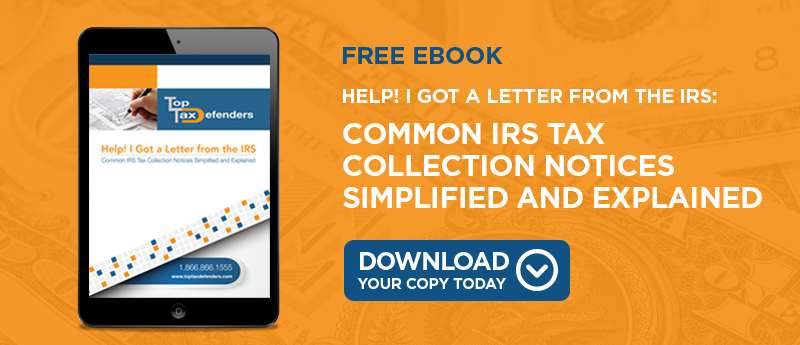
Tax liens — don’t you just hate them? They can be scary, but there’s no reason to panic. The situation isn’t as dire as you might believe, and help is available.
If you receive a Notice of Federal Tax Lien, you want to handle it as quickly and effectively as possible so you don't lose any assets. The IRS uses tax liens as "encouragement" for you to pay your taxes and to cement their interest in your property if you don’t.
However, the lien process has several steps, provisos, and intricacies that can either spell a less fraught experience or make things worse. It all depends on your response.
After determining your tax liability, the IRS places a lien, sending you a Notice and Demand for Payment (also known as a tax bill). Then you decide to ignore it or refuse to pay the taxes.
Just so we’re clear, the lien amount doesn’t just include your tax obligation. It also includes interest, additional amounts determined by the Federal government, additions to the tax, assessable penalties, and any costs. See Section 6321 of the Internal Revenue Code for details.
Before diving into what to do about a lien notification, let’s have a recap of what a lien is and isn’t.
Tax Liens 101
The IRS files tax liens against taxpayers who have unpaid tax balances. State and local governments can do the same thing, and the processes are similar.
The IRS can issue a Notice of Federal Tax Lien, but it doesn’t have to. In general, the notification is how the IRS puts itself into first place in any line of creditors. The Federal tax lien document is recorded with the county government where you live or do business, making it a public record. In fact, until the IRS issues the notice, the lien remains a secret from all other creditors.
If there is any good news about all this, it’s that the IRS rarely issues a lien unless you owe more than $10,000 in taxes. So, even if you receive a notice, the IRS may decide not to attach a lien if you owe less than this.
A Federal Notice of Tax Lien says the following:
“There is a lien in favor of the United States on all property and rights to property belonging to this taxpayer for the amount of these taxes, and additional penalties, interests, and costs that may accrue.”
The notice records the total amount you owe the IRS. If you sell any property with a lien attached, the IRS receives sales proceeds up to your balance before you receive a cent. Also, liens remain attached to a property, even if a third party takes ownership. It stays there until the taxpayer makes arrangements for its removal.
A lien is not a levy. A lien is a document declaring that the IRS is protecting the government's ability to collect money. A levy is the forced collection of tax, typically by property confiscation and sale or seizing money from your bank account or paycheck.
All About Lien Notifications
Before a tax lien arises, three things must happen.
- The IRS must perform an assessment of your tax obligation.
- The agency must send a Notice and Demand for Payment (tax bill).
- You must fail to pay (or do anything else about it).
In step 1, the IRS uses your filed tax returns, IRS audits, tax court decisions, or a determination of a tax error to assess the amount you owe. Then it mails the Notice and Demand for Payment to your residence or place of business. The letter goes to the last known address the IRS has on file.
The tax code requires the IRS to send the notice within 60 days of the assessment. However, if it misses the deadline, it does not invalidate the notice. If you pay in full within 10 days of the assessment date, you can avoid interest on your tax debt. Otherwise, the lien takes effect automatically.
While a lien notification is a public record that anyone can find at the county records office, it no longer appears in any of the three major credit bureaus credit reports. Seems there was a problem with accuracy, so in 2018, the bureaus stopped including them. That doesn’t mean that creditors can’t find out.
Preventing a Lien
How can you prevent a federal tax lien? Pay your taxes. It’s that simple.
If something prevents you from paying them in full, contact the IRS immediately to make other arrangements like an offer in compromise or enrollment in a guaranteed installment plan. You may need to pay a setup fee.
Keep in mind that until your balance continues to accrue interest and penalties until it’s paid in full.
How to Remove a Lien
The IRS removes a lien if:
- It was filed in error.
- The outstanding balance is paid in full or otherwise satisfied
- It becomes unenforceable because the 10-year statute of limitations has passed
- The property to which the lien is attached has more than doubled in value over the value of the tax obligation
- The IRS’s interest has no value
- A right of subordination has been filed
About that 10-year statute of limitations — it can get complicated. The collection time can start and stop, delaying the 10-year limit beyond the actual date. Also, the IRS will likely file suit for a judgment before the lien expires, so the lien continues until the judgment is met.
A tax lien is removed by withdrawal, release, or a discharge of property. Withdrawal usually means the IRS placed the lien in error, and it's like the lien never existed. If you receive a notice and believe the IRS made a mistake, contact them immediately to get the ball rolling on a withdrawal.
The IRS releases the lien within 30 days of full payment of your outstanding tax obligation. Many liens are released automatically. The IRS can also issue a removal if it will speed up the collection process or in the best interests of the taxpayer and IRS.
The Fresh Start Program provides eligible taxpayers a lien release if the outstanding balance is less than $25,000. If your balance is higher than that, you can transfer the debt to a credit card or home equity loan or by making payments until the total is under $25,000. Then you can apply for Fresh Start.
A discharge allows a taxpayer to sell a property free of the lien.
Subordination doesn’t remove a lien, but it does remove the IRS from first priority among creditors, allowing other creditors to move ahead of them to receive payments.
Final Note
A Federal Tax Lien can make obtaining a mortgage or other credit difficult. It remains attached to all existing assets and future assets acquired during the time the lien is in effect. Bankruptcy does NOT remove a lien.
If you receive a Notice of Federal Tax Lien, respond immediately. Determine if the IRS made an error or contact them to start the process of payment in installments or an offer in compromise.
Contact Top Tax Defenders to help you through this trying time. You don’t have to do it alone.




